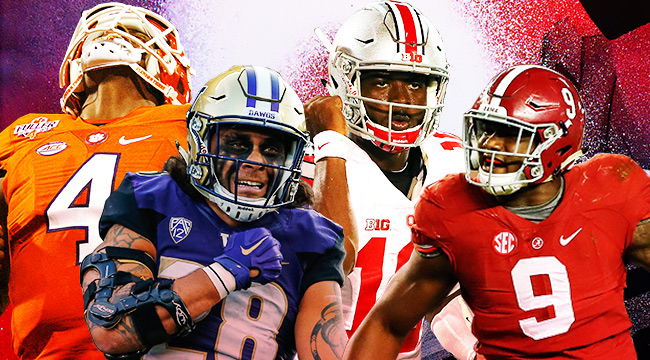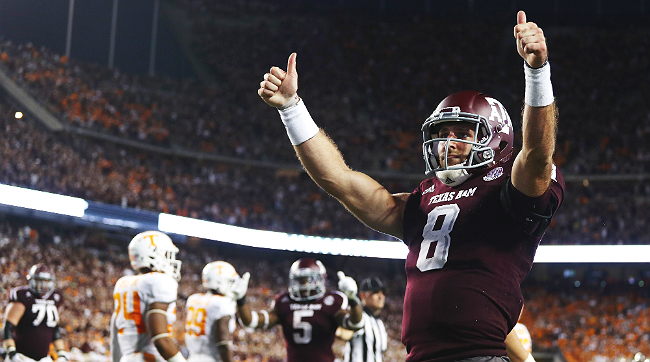
Believe it or not, this weekend marks the midway point of college football’s regular season, which is usually the point on the calendar when the season really begins to take on a shape of its own. What happens now is what you’ll actually remember: Freshmen mature, conference races unwind, Heisman contenders cement their legends. September upstarts are lapped in the polls by resurgent outfits that had been left for dead. Embattled coaches lose the thread. Enduring narratives begin to take root. Stakes get a little higher with each passing week. Arguments get specific. Sh*t gets real.
In most years, of course, the looming drama down the stretch draws most of its fuel from the vagaries of the playoff race (or, in bygone days, the BCS standings) which has never lacked for intrigue or uncertainty. Presumably speculation over the final four will suck up much of the remaining oxygen in 2016, too, either out of habit or as the result of an abrupt plot twist. Barring the latter, though, it’s already starting to look like this year’s great playoff debate will be notable mainly for what it lacks: Suspense.
Because at this stage, honestly, what’s to debate? In a typical year, it’s well into November before the logjam at the top of the polls yields to any kind clarity about how it’s likely to shake out. This year, the pecking order is so straightforward after just six weeks that, if the status quo holds, the final four is a foregone conclusion:
1. Alabama: The Crimson Tide have a relatively steep path from 6-0 to 12-0, starting with a pair of Top-10 opponents, Tennessee and Texas A&M, in consecutive weeks; the week after that, they have to play at LSU. But navigating that kind of gauntlet is nothing we haven’t seen from Nick Saban’s teams many times before. (Toughest remaining game, according to ESPN’s Football Power Index: at LSU, 61.4 percent)
2. Clemson: The Tigers have already survived the most pressing threat in the ACC, fending off Louisville in an instant classic. If we’re lucky, we’ll get to see one more on Oct. 29, against Florida State. Otherwise, FPI pegs Clemson’s chances of winning its other five games at more than 90 percent apiece. (Toughest remaining game: at Florida State, 57.2 percent)
3. Michigan or Ohio State: Can we just skip straight to the year-end, winner-take-all collision in Columbus already? Both sides have laid waste to all levels of competition, neither has trailed after halftime, and if OSU beats Wisconsin on Saturday (as expected) the advance hype in anticipation of Nov. 26 will be reminiscent of 2006. (Michigan’s toughest remaining game: at Iowa, 89.6 percent; Ohio State’s toughest remaining game: at Wisconsin, 70.5 percent)
4. Washington: Playoff speculation is uncharted territory for U-Dub, but even if you’re not fully sold on the Huskie renaissance yet — and you should be — who’s going to break it up? Washington has already destroyed the Pac-12 North’s usual heavy hitters, Stanford and Oregon, in consecutive weeks, and the conference’s only other ranked team this week is no. 21 Utah. (Toughest remaining game: at Washington State, 72.2 percent)
That’s it: Five teams vying for four spots, one of which will likely be decided in a head-to-head, de facto elimination game. Otherwise, all five will be solid to huge favorites in every remaining game they’ll play. (On that note, in addition to FPI, you can also get stat-based win projections for the rest of the schedule from Bill Connelly’s S&P+ ratings; the results are broadly similar.) With nearly two months still to play, that’s the most direct, no-questioned-asked path to filling the bracket imaginable.

Now, if that scenario strikes you as a little too black-and-white for a sport that often relishes chaos, history suggests you may be right. At least three other teams from power conferences control their playoff destinies, as well, including 6-0 Texas A&M, which could conceivably replace Alabama next weekend as the SEC’s default frontrunner; ditto 5-1 Tennessee, which didn’t budge at all in the polls after last week’s double overtime loss at A&M and can surge right back into the national picture on Saturday with an upset over Bama in Knoxville.
In the ACC, there’s still 4-1 Louisville, which should be heavily favored in the rest of its games but (with the possible exception of Houston on Nov. 17) won’t face a notable opponent in any of them; at any rate, even if Louisville does run the table to finish 11-1, it has almost no chance of playing for the ACC title after losing the Atlantic Division tiebreaker to Clemson.
And in the Big Ten, there’s 5-0 Nebraska, beneficiary of a quiet but rapid rise from unranked in the preseason AP poll to No. 10 in just a few weeks. If the Cornhuskers survive back-to-back road trips to Wisconsin and Ohio State with their perfect record intact they’ll be in the driver’s seat. How likely is that? Not very: FPI gives Nebraska less than a 35-percent chance of beating Wisconsin (34.0 percent) or Ohio State (11.2 percent), and just a 0.2-percent chance of running the table.
Meanwhile, A&M and Tennessee’s dreams of usurping Alabama will require one of them to, you know, beat Alabama; to that end, Tennessee is listed as a double-digit underdog against the Tide on Saturday, and depending on how it goes there A&M will probably find itself in the same position next week.
There are a couple unblemished records remaining in the Big 12, belonging to 5-0 Baylor and 4-0 West Virginia, but the league’s stock is so low right now that even an undefeated Big 12 champion would likely be regarded as last among equals compared to its major conference peers. Anyway, FPI lists Baylor as a projected underdog in two of its remaining games and WVU as an underdog in four. The Big 12 hasn’t produced an undefeated champion since 2009 (Texas), and it’s less likely to happen this year, with these teams left as the would-be standard bearers, than it’s ever been.
All of which is to say that from this point forward there are essentially two options: The status quo, reinforcing everything we think we know right now about the “Big Five” teams that have separated themselves over the first six weeks, or complete and utter chaos in its wake. Not that there’s anything wrong with chaos, especially if you’re one of the early disappointments that fell off the national radar in September (see: Stanford, Oklahoma, Florida State, Ole Miss, LSU, et al) but still has a chance to claw their way back into the discussion.
Oklahoma, for example, which plummeted from No. 3 on opening day to out of the polls entirely following double-digit losses to Houston and Ohio State, remains the favorite to win the Big 12 at 58.1 percent. More to the point, the Sooners are also likely to be favored to win in every game the rest of the way — enough dominoes fall in front of them, and a run like that could open up a path back to playoff viability. Just one or two upsets among the frontrunners could put a couple dozen new playoff scenarios into circulation.
But 2016 isn’t 2007, not by a longshot: Except for Washington, whose emergence is a year ahead of schedule, all of this year’s contenders fully expected to be in lofty positions and (including Washington) haven’t done anything to undermine their staying power. For now, they deserve to be where they are. If that’s still true in six weeks, then it will be safe to say whatever this season lacks in week-to-week volatility, it more than makes up for in clarity.






